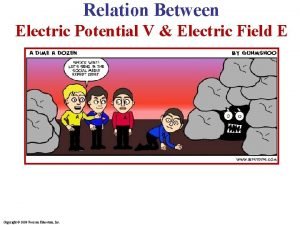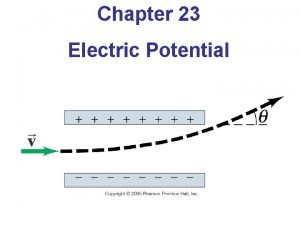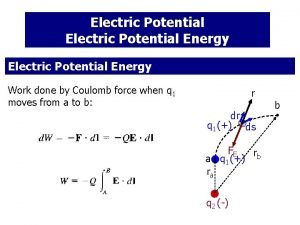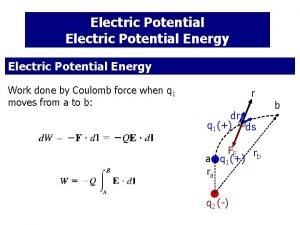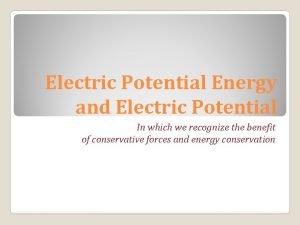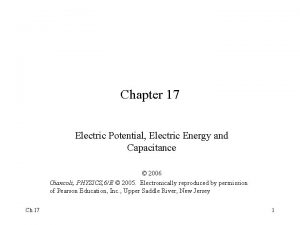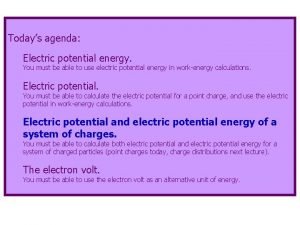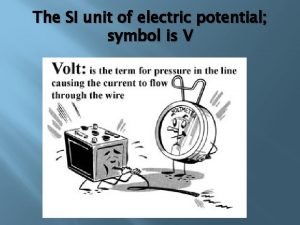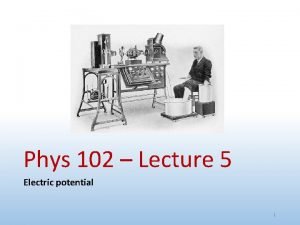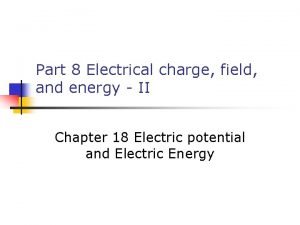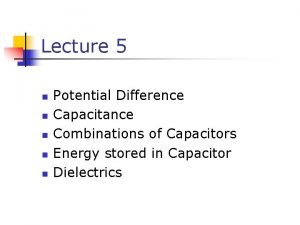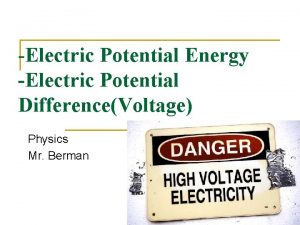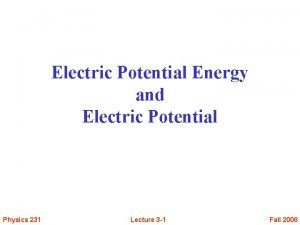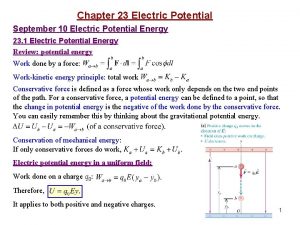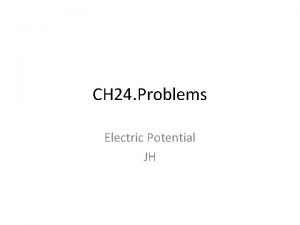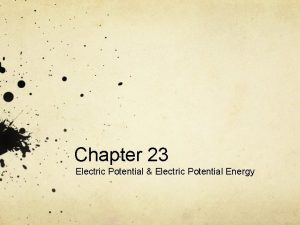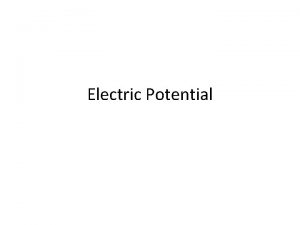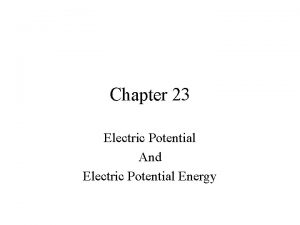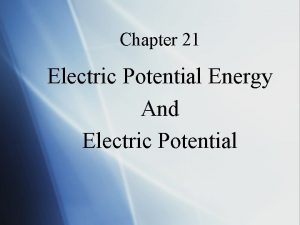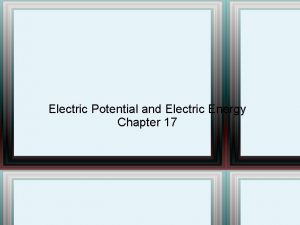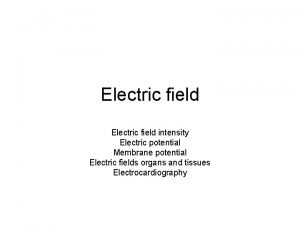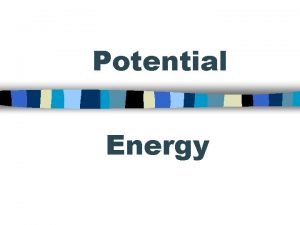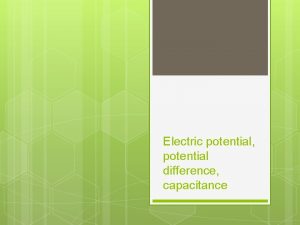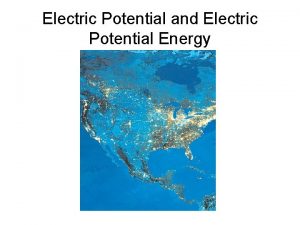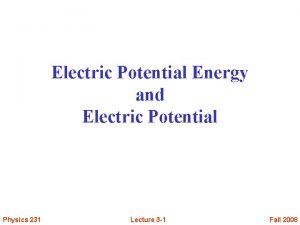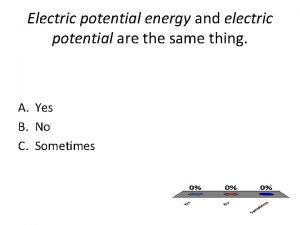Chapter 19 Electric Potential and Electric Potential Energy















































- Slides: 47

Chapter 19 Electric Potential and Electric Potential Energy

Chapter 19 • Electric Potential Energy and the Electric Potential • Energy Conservation • The Electric Potential of Point Charges • Equipotential Surfaces and the Electric Field • Capacitors and Dielectrics • Electrical Energy Storage

Chapter 19 • Electric fields are similar to gravitational fields-both involve action-at-a-distance forces. • Gravitational Field: - Energy in the form of work is done to move an object against its gravitational field to a higher position. - Gravitational potential energy is the energy an object gains/looses due to changes in vertical position (U=mgh). • Electric Field: - Work is required to move a charge against its electric field. - Electric potential Energy is the energy a charge gains/looses when moving with/against the force field (doesn’t have to be vertical) • Electric and Gravitational forces are both conservative.

Chapter 19 • Differences between electric fields and gravitational fields: • Gravitational Field: - Gravitational forces are only attractive. • Electric Field: - Electric forces are attractive or repulsive. - Charges have electric potential energy and electric potential, the two are different. - Electric potential does not have gravitational equivalent Electric forces are stronger than gravitational forces.

Chapter 19 Positive source charge is creating an electric field and a positive test charge is being moved against and with the field.

Chapter 19 Negative source charge is creating an electric field and a positive test charge is being moved against and with the field. Conclude: The low energy location for a positive test charge is a location nearest a negative source charge and the high energy location is a location furthest away from a negative source charge.

Chapter 19 Key Point: Work must be done by an external force to move an object or charge against nature i. e. from low potential energy to high potential energy. Conversely: Objects naturally move from high potential energy to low potential energy under the influence of the force field. • Easy to move from high energy to low energy but work is required to go from low energy to high energy. • Moving a charge in an electric field against its natural direction of motion requires work.

Potential Energy • Stored energy of an object, energy by virtue of its position. • Associated with restorative forces - Pull/stretch a spring, lift a box to a higher position, the force is stored in its force field as potential energy - Remove the external force, the force field acts on the object to bring it back to its initial position • Work equation shows that work is the gravitational, elastic or electric potential energy needed to bring the object back to its initial position.

Electric Potential Energy Introduce a positive charge into the electric field shown in Figure a below. Work needs to be done to move the positive electric charge in the opposite direction of the electric field. Since d and F are opposite directions, work will be negative. Work will be positive when it is in same direction as the force. F=q 0 E Recall potential energy: Substituting:

Electric Potential Energy and the Electric Potential Change in electric potential energy depends on the sign of the charge. Place a negative test charge in the positive field, the electric force acting on it will be upward, charge will move in its natural direction. F and d are in same direction so Work is positive: - Substitute the positive value of W into the potential energy equation below & we see that potential energy decreased.

Electric Potential Energy and the Electric Potential Electric potential (V): • The difference in electric potential energy between two points • Imparts 1 J of energy per coulomb of charge that passes through the difference. • Location dependent, as is electric potential energy • Often referred to as “potential” or “potential difference”. In circuits: Electric potential is the amount of electric energy that could be released if electric current is allowed to flow.

Electric Potential Energy and the Electric Potential If electric potential is 12 Joules per coulomb at a particular location in the electric field, than any charge at that location would have an electric potential of 12 Joules per coulomb but each charge would possess a different amount of electric potential energy at that location depending on the amount of charge the object has. 2 coulomb object would have 24 J of potential energy 0. 5 coulomb object would have 6 J of potential energy. Electric potential energy per charge Energy associated with electric force SI Unit: joule, J

Electric Potential Energy and the Electric Potential Connection between Electric Field and Electric Potential: The electric field is related to how fast the potential is changing: Minus sign means electric potential is decreasing over distance

Electric Potential Energy and the Electric Potential Example: Light bulb. Electric potential decreases when positive charge moves in direction of the electric field. Positive terminal is an area of high potential & high potential energy, negative terminal is low potential and low potential energy. Electric potential energy is carried through the circuit to the light bulb where it is converted to light, remaining electric potential energy is carried back by the charge to the negative terminal where the circuit is repeated.

2. A uniform electric field of magnitude 4. 1 x 105 N/C points in the positive x direction. Find the change in electric potential energy of a 4. 5�� C charge as it moves from the origin to the points (a) (0, 6. 0 m) (b) (6. 0 m, 0) and (c) 6. 0 m, 6. 0 m).

4. In a typical living cell the electric potential inside the cell is 0. 070 V lower than the electric potential outside the cell. The thickness of the cell membrane is 0. 10 �� m. What are the magnitude and direction of the electric field within the cell membrane?

7. A parallel-plate capacitor has plates separated by 0. 75 mm. If the electric field between the plates has a magnitude of (a) 1. 2 x 105 V/m or (b) 2. 4 x 104 N/C , what is the potential difference between the plates?

12. HOMEWORK A uniform electric field with a magnitude of 1200 N/C points in the negative x direction, as shown in the figure. (a) What is the difference in electric potential, ΔV =Vb - Va, between points A and B? (b) What is the difference in electric potential, ΔV = Vb - Vc, between points B and C? (c) What is the difference in electric potential, ΔV = V c Va, between points C and A? (d) Is it possible to determine the value of the electric potential at point A?

Energy Conservation In general, for a mass moving from A to B due to a conservative force, Equation of energy conservation For the electric force, so that Release particle into electric field: it will move in the direction of the electric field, with decreasing electric potential energy & increasing kinetic energy. Particle’s speed increases because its kinetic energy increases.

Energy Conservation • Positive charges accelerate (increase speed) in the direction of decreasing electric potential. Positive charges move to regions of lower electric potential with increasing speed. High potential is around the positive charge creating the field. • Negative charges accelerate (increase speed) in the direction of increasing electric potential. Negative charges move to regions of higher electric potential with increasing speed. In both cases, the charge moves to a region of lower potential energy. Remember: energy conservation so electric potential energy is being converted to kinetic and back to EPE, no conversion to other forms of energy (i. e. heat) so negative charge accelerating to higher EP means it accelerates to the positive sign and is “swimming downstream”, positive charge is also moving with nature.

Electric Field Overview Electric potential energy (U): The amount of stored electrical energy a charge possesses gained from the amount of work expended in moving the charge from one point to another against an electric field. • Positive charge has low electric potential energy when located near a negative source charge and high potential energy when moved farther away from the negative source charge. • Negative charge has low electric potential energy when located near a positive source charge and high potential energy farther away from the positive source charge. Electric potential (V) is a measure of the change in electric potential energy per charge and is a scalar. Often referred to as “potential” or “potential difference”. • Measures the effect of the electric field on the charge, a measure of the energy per unit charge. - Positive charges accelerate in the direction of decreasing electric potential - Negative charges accelerate in the direction of increasing electric potential. • In both cases, charge moves to a region of lower electric potential energy.

The Electric Potential of Point Charges The difference in potential energy between points A and B is Since we can set potential = 0 at any convenient location, choose location B which means we set electric potential to be zero infinitely far from a given charge so r. B goes to zero. Corresponding change in electric potential of a point charge becomes: and for two point charges : V still represents a change in electric potential: change in electric potential from a distance of infinity to a distance r. k =8. 987551789 x 109 N. m 2/C 2

26. The electric potential 1. 1 m from a point charge q is 2. 8 x 104 V. What is the value of q?

Equipotential Surfaces and the Electric Field On a contour map, the curves mark constant elevation; the steepest slope is perpendicular to the curves. The closer together the curves, the steeper the slope.

Equipotential Surfaces and the Electric Field Positive charge located at the origin: The potential increases to positive infinity near the origin and decreases to zero farther away when a test charge closer to or farther from the positive charge at the origin--the positive test charge is climbing uphill (moving against nature) closer to the positive charge at the origin. Negative charge located at the origin: Positive test charge will move toward the origin, sliding downhill.

Equipotential Surfaces and the Electric Field Electric potential and the electric field have the same relationship – lines (or surfaces) of constant potential. Electric field is perpendicular to the equipotential lines, and strongest where the lines are closest together. On the green lines, the value of the potential is the same as you go around the circle but different from circle to circle--each circle is an equipotential surface. Electric field is strongest near origin demonstrating electric field equals the rate of change of potential with position. Electric field always points in direction of decreasing electric potential & is always perpendicular to the equipotentials

Equipotential Surfaces and the Electric Field For two point charges:

Equipotential Surfaces and the Electric Field An ideal conductor is an equipotential surface. If two conductors are at the same potential, the one that is more curved will have a larger electric field around it. This is also true for different parts of the same conductor.

Equipotential Surfaces and the Electric Field Electric fields exist inside the human body; the body is not a perfect conductor, so there also potential differences. An electrocardiograph plots the heart’s electrical activity: Heart muscle contracts, causing potential differences around 1 m. V. EKG detects these differences.

Equipotential Surfaces and the Electric Field An electroencephalograph measures the electrical activity of the brain. Potential differences are about 0. 1 m. V, much smaller than the heart.

48. Consider a region in space where a uniform electric field E=6500 N/C points in the negative x direction. (a) What is the orientation of the equipotential surfaces? (b) If you move in the positive x direction, does the electric potential increase or decrease? (c) What is the distance between the +14 V and the +16 V equipotentials?

Capacitors and Dielectrics A capacitor is two conducting plates separated by a finite distance. Capacitor stores both electric charge and energy. Connect the capacitor to a battery to charge the plates. The greater the charge Q for a given voltage the greater the capacitance of the capacitor. C relates charge to the magnitude of the electric potential (aka potential difference, voltage) across the plates. Capacitance depends on the ratio of Q and V

Capacitors and Dielectrics A simple type of capacitor is the parallel-plate capacitor which has a uniform electric field. It consists of two plates of area A separated by a distance d. By calculating the electric field created by the charges ±Q, we find that the capacitance of a parallel-plate capacitor is: Capacitance increases with the area of the plates: the greater the area the more charge it can hold. C is inversely proportional to plate separation: greater separation the greater the potential difference required to store a charge.

Capacitors and Dielectrics A dielectric is an insulator; when placed between the plates of a capacitor it gives a lower potential difference with the same charge, due to the polarization of the material. This increases the capacitance.

Capacitors and Dielectrics The polarization of the dielectric results in a lower electric field within it; the new field is given by dividing the original field by the dielectric constant κ: Therefore, the capacitance becomes:

Capacitors and Dielectrics The dielectric constant is a property of the material; here are some examples:

Capacitors and Dielectrics Capacitors store charge and energy. If the electric field in a dielectric becomes too large, it can tear the electrons off the atoms, thereby enabling the material to conduct. This is called dielectric breakdown; the field at which this happens is called the dielectric strength.

50. A 0. 40 µF capacitor is connected to a 9. 0 V battery. How much charge is on each plate of the capacitor?

53. A parallel-plate capacitor s made from two aluminum foiled sheets, each 6. 3 cm wide and 5. 4 m long. Between the sheets is a Teflon strip of the same width and length that is 0. 035 mm thick. What is the capacitance of this capacitor?

Electrical Energy Storage By considering how much energy it takes to move an increment of charge, ΔQ, from one plate to the other, we can find the total energy stored in the capacitor:

Electrical Energy Storage The energy stored in a capacitor can be put to a number of uses: a camera flash; a cardiac defibrillator; and others. In addition, capacitors form an essential part of most electrical devices used today. If we divide the stored energy by the volume of the capacitor, we find the energy per unit volume; this result is valid for any electric field:

67. Find the electric energy density between the plates of a 225μF parallel-plate capacitor. The potential difference between the plates is 345 V, and the plate separation is 0. 223 mm.

Summary of Chapter 19 Electric force is conservative, and has a potential energy associated with it Change in electric potential energy: Change in electric potential: Relation between electric field and electric potential: Total energy (electric potential energy plus kinetic energy) is conserved

Summary of Chapter 19 Positive charges accelerate in the direction of increasing potential Negative charges accelerate in the direction of decreasing potential Electric potential of a point charge: Electric potential energy of two point charges: Total electric potential and total electric potential energy are sums of those due to individual charges

Summary of Chapter 19 Equipotential surfaces are those on which the electric potential is constant. The electric field is perpendicular to the equipotential surfaces. Ideal conductors are equipotential surfaces. A capacitor is a device that stores electric charge. Capacitance:

Summary of Chapter 19 Capacitance of a parallel-plate capacitor: A dielectric is an insulator that increases a capacitor’s capacitance. A dielectric is characterized by its dielectric constant. A sufficiently large electric field can cause a dielectric to break down.

Summary of Chapter 19 A capacitor also stores electric energy. Electric energy stored in a capacitor: Energy density in an electric field:
 Electric potential vs electric potential energy
Electric potential vs electric potential energy Electric potential units
Electric potential units Pe=qed
Pe=qed Define electric potential and potential difference.
Define electric potential and potential difference. Electric potential inside non conducting sphere
Electric potential inside non conducting sphere Potential energy due to point charges
Potential energy due to point charges Electric field strength formula
Electric field strength formula Electric potential and electric field
Electric potential and electric field Relation between e and v
Relation between e and v Electric potential to work
Electric potential to work Force is the integral of potential energy
Force is the integral of potential energy Work done by coulomb force
Work done by coulomb force Electrical potential energy
Electrical potential energy Absolute potential energy
Absolute potential energy Kinetic energy in electron volts
Kinetic energy in electron volts Energy formula
Energy formula Potential energy of system of charges
Potential energy of system of charges Symbol for electric potential
Symbol for electric potential Electric potential energy
Electric potential energy Energy stored in capacitor
Energy stored in capacitor Electrostatic potential energy
Electrostatic potential energy Gpe=mgh example
Gpe=mgh example Electric potential energy
Electric potential energy Electric potential formula
Electric potential formula What is kinetic energy
What is kinetic energy Kinetic energy and potential energy formula
Kinetic energy and potential energy formula Kinetic energy and potential energy formula
Kinetic energy and potential energy formula The change in mechanical energy
The change in mechanical energy Chapter 33 electric fields and potential
Chapter 33 electric fields and potential Chapter 21 electric charge and electric field
Chapter 21 electric charge and electric field Chapter 21 electric charge and electric field
Chapter 21 electric charge and electric field Units of charge
Units of charge Units of a charge
Units of a charge Gravitational potential energy formula
Gravitational potential energy formula Potential energy to chemical energy examples
Potential energy to chemical energy examples Mechanical examples
Mechanical examples Gravitational potential energy vs kinetic energy
Gravitational potential energy vs kinetic energy Potential energy vs kinetic energy
Potential energy vs kinetic energy Energy energy transfer and general energy analysis
Energy energy transfer and general energy analysis Energy energy transfer and general energy analysis
Energy energy transfer and general energy analysis Chapter 23 electric potential
Chapter 23 electric potential Electrical potential
Electrical potential Graded potential
Graded potential Water potential
Water potential Market potential and forecasting
Market potential and forecasting Electric potential problems and solutions
Electric potential problems and solutions Electric charges and electric forces lesson outline
Electric charges and electric forces lesson outline How to find pressure potential
How to find pressure potential








